You’ll find Burke nestled in a 300-foot-wide canyon of Idaho’s Silver Valley, where rich lead-silver-zinc deposits sparked a mining rush in 1884. The town grew rapidly to 1,400 residents by 1910, with the iconic Tiger Hotel famously built over railroad tracks that ran through its lobby. After decades of mining activity, labor conflicts, and environmental challenges, Burke’s population dwindled to just 15 residents when its last mine closed in 1991, leaving behind fascinating architectural remnants of its innovative past.
Key Takeaways
- Burke was a bustling mining town established in 1887 in Idaho, known for its rich lead-silver-zinc deposits and unique railroad-through-hotel design.
- The town’s population peaked at 1,400 residents in 1910 but declined dramatically to just 15 people after mines closed in 1991.
- Located in a narrow 300-foot-wide canyon, Burke’s buildings were built over Canyon Creek and railroad tracks, creating a distinctive linear layout.
- The iconic Tiger Hotel accommodated trains running through its lobby five times daily and served as the town’s social hub until 1954.
- Environmental damage from mining operations, including toxic tailings and heavy timber harvesting, left lasting impacts on the local ecosystem.
A Mining Town Born in Silver and Lead
When prospectors discovered rich deposits of lead-silver-zinc ore on May 2, 1884, they launched Burke, Idaho’s remarkable mining saga.
You’ll find the story began with the Tiger and Poorman claims, staked on opposite sides of Burke Canyon, sparking a rush that led to over 70 mining claims along Canyon Creek. The town formally established itself in 1887 as a crucial hub for these operations. By 1898, the Tiger and Poorman mines contributed 14% of all ore production in the region.
Early mining techniques were primitive, with stamp mills, jigs, and vibrating tables recovering less than 75% of metals from ore.
The environmental impact was severe – tailings loaded with lead, arsenic, and zinc were dumped directly into Canyon Creek or nearby hills. Heavy timber harvesting stripped the surrounding hillsides, increasing erosion and flooding in the narrow canyon that would shape Burke’s destiny. The nearby Hercules Mine, discovered in 1889, would become one of the area’s most significant operations.
Life in the Narrowest Canyon
If you’d visited Burke during its mining heyday, you’d have found yourself maneuvering a town squeezed into a mere 300-foot-wide canyon where buildings were constructed directly over Canyon Creek and the railroad tracks.
You’d have witnessed trains rumbling through the middle of town, even passing through buildings like the Tiger Hotel, where travelers could step directly from the train into the hotel lobby. To maximize the limited space, residents built outhouses on stilts over the creek.
Living in such tight quarters meant that Burke’s residents adapted to unique conditions, including the daily routines of dodging trains and dealing with the constant echo of mining operations bouncing off the narrow canyon walls. The town’s challenging environment would have been familiar to professional boxer Sailor Burke, who was known for navigating tight spots in the ring.
Cramped Living Conditions Daily
Because Burke Canyon measured only 300 feet wide at its narrowest point, residents endured extraordinarily cramped living conditions that shaped every aspect of daily life.
The severe space limitations meant you’d find yourself living in dilapidated wooden structures perched precariously on steep canyon walls, with minimal privacy from your neighbors. Labor disputes and violence often erupted in the confined quarters, leading to intense community conflicts. The community peaked at 1,400 residents in 1910, making the cramped conditions even more challenging.
Daily life in these cramped spaces exposed you to:
- Trains rumbling through the center of town, sometimes directly through buildings like the Tiger Hotel’s lobby
- Constant noise and dust from nearby mining operations infiltrating your home
- Primitive sanitation, with outhouses positioned over the river due to lack of proper sewage infrastructure
The cramped space created serious sanitation issues, as waste and mining effluvia accumulated in the narrow canyon, making living conditions increasingly hazardous for residents.
Railroad Through Main Street
As Burke’s narrow canyon offered minimal space for development, the Northern Pacific Railroad laid its tracks directly through the heart of the town in 1887.
You’d find the railroad layout running straight down Main Street, with buildings pressed tightly against or spanning over the tracks due to the 300-foot-wide canyon challenges.
In 1890, a second railroad joined the cramped space when the Oregon Railroad and Navigation Company added their tracks.
The most striking example of Burke’s adaptation was the Tiger Hotel, where trains would pass directly through its lobby five times daily.
A devastating fire in 1923 destroyed much of the railroad infrastructure along with over fifty businesses in the town.
This unique arrangement showcased the town’s innovative solutions to space constraints, while efficiently serving the booming mining operations that produced thousands of tons of lead, silver, and zinc ore.
The bustling mining community reached its peak with 1,400 residents in 1910, reflecting the town’s prosperity during the height of its mining operations.
The Remarkable Tiger Hotel
You’ll find it hard to believe that a hotel could accommodate trains running through its lobby, but the Tiger Hotel in Burke managed just that when it opened in 1888.
Built to span Canyon Creek in a space barely 100 yards wide, this engineering marvel supported not only railroad tracks and the town’s main street through its ground floor, but also housed 150 rooms and fed 1,200 people daily at its peak.
Five passenger trains passed directly through the building each day, making the Tiger Hotel the only known establishment in the American West where you could watch locomotives roll through the lobby while checking in. A devastating grease fire damaged the hotel’s kitchen in 1897, but operations continued.
After decades of service, the hotel was eventually purchased by Ed Woods of Osburn in 1954, leading to its ultimate demolition that same year.
Unique Railroad Design Features
While many hotels of the era aimed to impress with grand lobbies, the Tiger Hotel in Burke, Idaho achieved architectural fame through its remarkable integration of railroad infrastructure.
You’d find this unique hotel design spanning the entire width of Burke Canyon, which was only 300 feet wide. The railroad architecture wasn’t just nearby – it ran directly through the hotel’s first floor.
- Two separate railroad lines passed through the hotel lobby, with five passenger trains running daily
- Travelers could step directly from the train into the hotel’s main entrance
- The building also accommodated the town’s only highway and Canyon Creek beneath its structure
This innovative design maximized every inch of available space in the narrow canyon while creating unprecedented convenience for railway travelers.
Engineering Over Canyon Creek
The Tiger Hotel’s innovative engineering conquered the challenges of Burke’s narrow canyon through remarkable structural adaptations. Spanning wall-to-wall across the canyon sides, this three-story timber marvel accommodated both Canyon Creek and railroad tracks running directly through its foundation.
You’ll find that the hotel’s canyon engineering included retaining walls for level ground and strategic positioning over the creek using stilts and cantilevers.
When the Northern Pacific Railroad needed wider tracks in 1906, the hotel adapted its structure accordingly. After a devastating 1923 fire split the building in two, an enclosed walkway was built above the tracks to protect guests from trains and weather.
Despite recurring floods, fires, and space constraints, the Tiger Hotel’s structural adaptations helped it survive until 1954, embodying Burke’s resourceful spirit.
Daily Life Inside Hotel
Life inside the Tiger Hotel buzzed with constant activity as miners, families, and railroad workers shared the unique space from its 1896 opening.
You’d find a bustling atmosphere where community gatherings and hotel dining brought locals together over flavorful, affordable meals.
The hotel’s distinctive features made daily life an adventure:
- Trains rumbled through the lobby, creating an unforgettable experience
- The kitchen and bakeshop filled one building with enticing aromas
- 150 rooms spread across three floors (later four) housed a mix of miners and travelers
Even during wartime conditions in 1942, you’d experience high-quality accommodations and service.
The Tiger Hotel continued serving as Burke’s social hub until the 1940s, when it transformed into an apartment building before its eventual demolition.
Mining Conflicts and Labor Struggles

Mining conflicts erupted in Burke during the 1890s, transforming the quiet canyon town into a battleground between union miners and mine owners.
Labor tensions first surfaced at the Tiger-Poorman mine in 1890 over poor food quality, but by 1892, the situation had escalated dramatically.
What began as complaints about miners’ meals in 1890 soon grew into full-scale labor unrest at Burke’s Tiger-Poorman mine.
Strike violence reached its peak when imported strikebreakers arrived by train, met by armed union miners determined to protect their jobs.
The bloodiest confrontation occurred at the Gem mine, where six men died in a fierce gunfight.
You’d have witnessed union miners taking 150 strikebreakers prisoner, followed by the Idaho National Guard’s arrival to restore order.
The conflicts intensified again in 1899 when miners used dynamite to destroy the Bunker Hill & Sullivan mill, prompting federal intervention.
The Rise and Fall of Burke’s Population
Following rich silver and lead discoveries in Burke Canyon in 1884, you’d have witnessed a rapid population surge transform this narrow mountain settlement into a bustling mining hub.
The population dynamics tracked closely with the mining industry’s fortunes, growing from 482 in 1890 to a peak of 1,400 by 1910.
The socioeconomic impacts of mining’s decline became evident as Burke’s population steadily decreased:
- 1920s-1940s: Numbers fell from 1,135 to 963 as mining operations struggled
- 1950s-1970s: Sharp decline from 800 to just 150 residents
- 1980s-1990s: Final collapse to 15 residents with the last mine’s closure in 1991
Burke’s confinement within a 300-foot-wide canyon limited its growth potential, while dependence on mining ultimately sealed its fate as a ghost town.
Architectural Marvels in a Confined Space

Built within a canyon barely 300 feet wide, Burke’s architecture exemplifies some of history’s most creative solutions to extreme spatial constraints.
You’ll find the town’s canyon architecture most dramatically displayed in the Tiger Hotel, which ingeniously spanned railroad tracks, a roadway, and Canyon Creek – all passing directly through its lobby. When trains approached, workers would roll up awnings on nearby buildings to let them pass.
The innovative design didn’t stop there. With limited ground space, structures reached upward and bridged across obstacles, combining multiple uses into single buildings.
While wooden structures eventually succumbed to fires and avalanches, the surviving brick and stone buildings showcase how builders maximized every inch of the narrow corridor, creating a unique linear town where the railroad served as the main street.
From Bustling Mining Hub to Tourist Attraction
When silver, lead, and zinc deposits were discovered in Burke Canyon in May 1884, the area quickly transformed from a quiet mountain valley into one of Idaho’s most productive mining districts.
You’ll find that Burke’s evolution from boomtown to ghost town tourism destination tells a compelling story of the American West’s mining heritage.
- At its peak in the early 1900s, you’d have encountered 1,400 residents, bustling mines, and trains running through the Tiger Hotel’s lobby.
- The town’s decline accelerated after the devastating 1923 fire, which destroyed fifty businesses and left 600 homeless.
- Today, you can explore the authentic ruins and Hecla Mining Company structures without the commercial trappings of typical tourist ghost towns.
The site’s historical preservation efforts maintain Burke’s raw character, offering you an unfiltered glimpse into America’s mining past.
Frequently Asked Questions
What Happened to the Tiger Hotel and When Was It Demolished?
You’ll find that the Tiger Hotel declined through the 1940s, changed from a hotel to apartments, and met its final fate in 1954 when Ed Woods had it demolished due to vandalism.
Are There Any Active Mining Claims Still Present in Burke?
Yes, you’ll find 3,683 active claims in Burke today, continuing its rich mining history. While most of the area’s 29,087 historical claims are inactive, current claims maintain mineral rights and exploration opportunities.
What Paranormal Activities Have Been Reported in Burke’s Abandoned Buildings?
You’ll find numerous ghost sightings in Burke’s abandoned structures, with visitors reporting eerie noises like footsteps, distant knocking, and whispers. Many experience being watched, especially near the old church and mining buildings.
How Dangerous Is It to Explore Burke’s Remaining Structures Today?
You’re facing severe risks as many buildings lack structural integrity and could collapse. Without proper safety precautions like sturdy boots and flashlights, exploring these hazardous structures could be life-threatening.
What Environmental Impact Did Burke’s Mining Operations Have on the Landscape?
Like a poison seeping through veins, Burke’s mines devastated the environment. You’ll find decades of soil contamination from toxic metals, widespread habitat destruction, and polluted waterways that still plague the landscape today.
References
- https://idaho.com/history/burke/
- https://yoretown.com/2023/08/21/the-tragic-tale-of-burke-idaho/
- https://www.americanheritage.com/shoot-out-burke-canyon
- https://westernmininghistory.com/towns/idaho/burke/
- https://visitnorthidaho.com/activity/burke-canyon/
- https://www.atlasobscura.com/places/burke-ghost-town
- https://cdabasin.idaho.gov/the-dirt-mining-in-burke-canyon/
- https://en.wikipedia.org/wiki/Hercules_silver_mine
- http://sfcompanion.blogspot.com/2020/06/burke-idaho-ready-for-almost-century-of.html
- https://en.wikipedia.org/wiki/Burke



